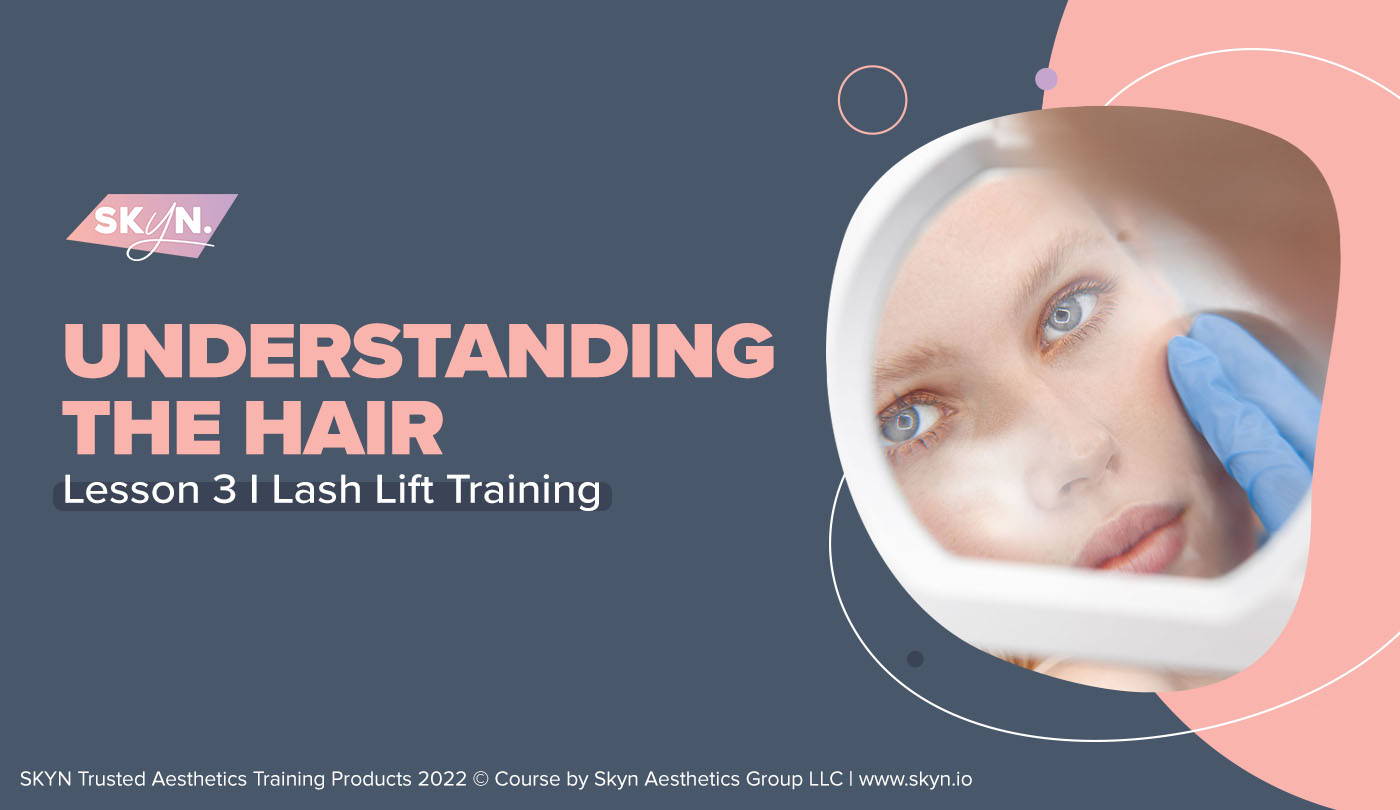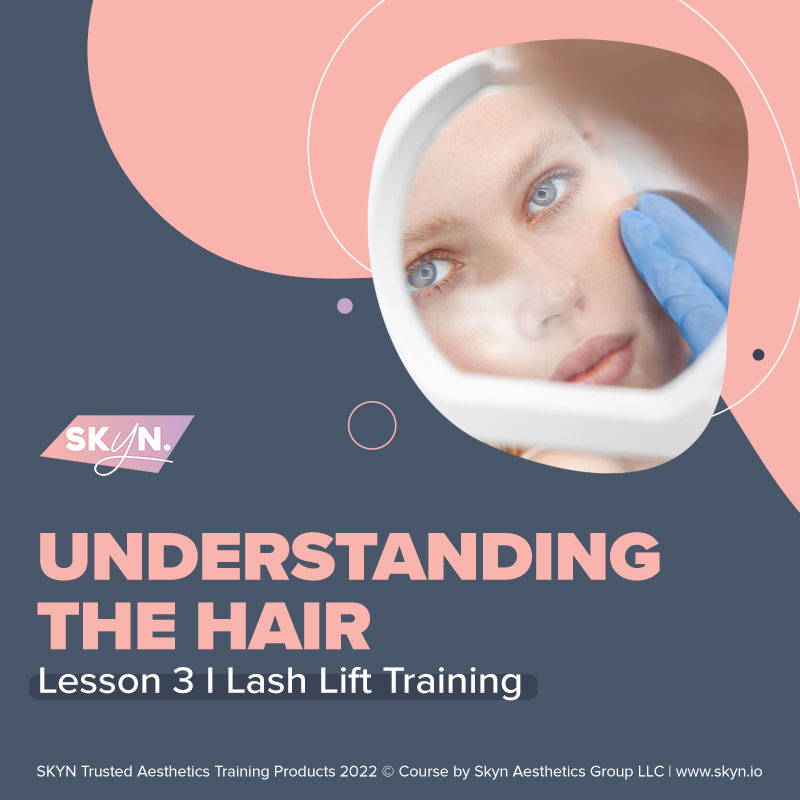

ANATOMY OF THE hair
Understanding eyelash hair
Hair, no matter the location, grows out of follicles also known as ‘hair bulbs’. These follicles or hair bulbs grow between the hypodermis and the deeper layers of the dermis. Each hair strand consists of two distinct parts, the follicle inside the skin, and the shaft which is the part we see above the skin. Glands surround the hair shaft with the sebaceous gland being the most important. The sebaceous gland secretes a natural lubricant for the hair called sebum.
Under the skin, at the follicle of the hair bulb’s base is the papilla. The papilla is the part of the follicle that houses capillaries, or tiny blood vessels, that provide nutrients such as amino acids, mineral salts, or vitamins to the hair. These capillaries are how hairs receive their nutrients and remain healthy.
Hair is 95% keratin, a chain-like protein found in the hair, skin, and fingernails. Keratin is a helix shaped (helicoidal) filament-forming protein that serves as an intermediate protein protecting and serving as a barrier. Keratin is insoluble in water, acids, solvents, or alkalines allowing keratin to serve as a barrier and mostly unaffected by the body’s chemicals. Even though keratin is insoluble, it relies on water (hydration) to maintain the overall function and size.
Once the hair exits through the surface of the skin, it isn’t alive anymore and becomes a hair shaft. The structure of a hair shaft is divided into 3 distinct, hardened layers of keratin:
1. Medulla
The inner layer or core of the hair shaft. It isn’t found in every hair type, but often absent in fine or light blonde hair. This core holds the moisture and consists of a soft, oily substance.
2. cortex
The middle layer of the hair shaft. 90% of the hair's weight is in this layer with many different functions. This layer is made by elongated cells forming a fibrous substance, giving hair strength and elasticity. Hair color pigment (melanin) derives from this layer as well. Hair treatments such as relaxers, perms, hair coloring all take place in the cortex. Over processing of this area with chemicals can damage this area, causing dry and brittle hair.
3. cuticle
The outermost layer of the hair composing of scale-like or shingle-like cells overlapping one another. This outermost layer protects the inner structures from damage and controls the water content of hair fiber. Chemical treatments raise the shingle-like cells up allowing the solutions to enter the cortex layer creating the perm, relaxer, or color change.

WHAT YOU WILL LEARN
LESSON 1
hair growth
stages of hair growth
1. Anagen
This is the active stage of hair growth. Cells in the root of the hair divide rapidly to form new hairs. These new hairs form, push through the club hair (a hair no longer in the anagen phase or has stopped growing), up the follicle, and out. Scalp hair can usually stay in this stage of growth for 2 to 6 years which is why your hair continues to grow longer. However, your brow and eyelash hairs have a very short active phase of 30 to 45 days, which is why they’re so much shorter.
2. catagen
This is the transitional phase lasting from 2-3 weeks. During this stage the hair stops its growth, detaches itself from the blood supply, and becomes a club hair.
3. telogen
The final stage of hair growth that begins with a resting phase. The club hair root rests. Below this you have new hair beginning to grow and hair can be in this phase for around 3 months.
EYelash After care
- Perm setting can take up to 24 hours
- Keep eyelashes dry and avoid wetting the lash area for 24 hours
- Avoid direct sunlight, steam rooms, swimming pools, and sunbeds for the next 48 hours.
- Do not rub, scratch, or traumatize for 24 hours
- NO NOT wear contact lenses during or after the procedure for at least 1 day
- DO NOT wash or exfoliate with any form of a scrub for at least 3 days
- NO anti-aging skincare around the brows for 3 days
- DO NOT use any fake tanning products, including gradual tan for 3 days; this can cause discoloration of your brows
- DO NOT use makeup around the area or on your brows for 24 hours
- After 8 weeks the client can come in for a touch up session.
Following all these after care instructions will give you the best results possible and increase the longevity of the lift.
AT HOME AFTERCARE KIT
Eyelash lift aftercare
what to expect
The results from a lash lift are instantaneous. Clients should adhere to the after-care instructions to ensure their lift is maintained. As with any perming, the hair and area needs to remain dry for at least 24 hours. If the hair does become wet, the lift can possibly be undone.
how long does a lash lift last?
A Last Lift can last up to 8 weeks to 10 weeks.
Your permanency depends on your hair growth cycle. As discussed earlier in this lesson, your new hair growth cycle can take 8 weeks which determines how long your lift will remain in tact. For some people, their results can last up to 10 weeks because their hair growth cycle is for a longer time period.
benefits of lash lift procedures
Ideal option for clients who want a simple, quick lash enhancement.
Lash Lifts are all skin types friendly and worthwhile investment.
LESSON 3 RECAP
Let's go over everything we have learned in this lesson. It's valuable to review the highlights of recently absorbed information to help the new knowledge stick. We hope you're enjoying the course so far and we'll see you in the next lesson.
What are the 3 major sections hair shafts can be broken down into?
The Medulla which is the inner most layer of the hair shaft containing the moisture and oils. It's often absent in fine or light blonde hair. The Cortex is the middle layer of the hair shaft with multiple functions. It is composed of elongated cells giving the hair strength and flexibility. The perming solutions all take place in this area. The Cuticle is the outermost payer of the hair comprised of scale-like cell overlapping to serve as a protective layer.
What are the 3 stages of hair growth?
Anagen is the active stage of hair regrowth when cells divide and form new hairs. This stage usually lasts 2-6 years. Catalan is the transitional phase last 2-3 weeks when hair detaches from the blood supply and becomes club hair. Telogen is the final hair stage it's the final stage when hair rests and grows .
How long does new hair growth take?
It can take 4-6 weeks to begin and new hairs can grow 0.14 to 0.16 mm per day.
What are some After-care protocols:
No makeup on the lashes area for up to 24 hours, do not touch the area with your finger, no picking or peeling, and no washing for 24 hours minimum. Client can return 8 weeks later for a touch up.
How long does it take for the perm to set?
The perming solution can take 24 hours to completely set.
How long will the lash lift last?
They can last for 8 weeks and at most 10 weeks.
any Questions?
Please email us at edu@skyn.io | It may take up to 48 hours to reply